October 9, 2009
Air Date: October 9, 2009
FULL SHOW
SEGMENTS
A Sea Change for Ocean Management
/ Jeff YoungView the page for this story
The Obama administration is proposing a sea change in how we manage our oceans, including a comprehensive policy on fishing, offshore energy, and shipping. Some scientists call it a needed remedy for our depleted coasts. Some fishermen worry they’ll be forced off the water. Host Jeff Young went to a hearing in Rhode Island and talked with marine officials, fishermen and NOAA Administrator Jane Lubchenco about using our oceans without using them up. (07:50)
Acid in the Arctic
View the page for this story
Arctic waters are rapidly turning acidic, even faster than originally thought. New research from oceanographer Dr. James Orr of the Laboratory for the Sciences of Climate and Environment in Paris predicts that the Arctic Ocean will be corrosive enough to dissolve shells of clams, mussels and others within the next decade. Host Jeff Young talks with Dr. Orr about the mounting crisis in the Arctic Ocean. (04:00)
Chemical Reform
View the page for this story
For 30 years, EPA has been forced to rely on industry to police itself to protect the public from hazardous chemicals. Now, the agency aims to re-invent the Toxic Substances Control Act, or TOSCA, to give EPA greater regulating authority. Host Jeff Young talks with Dr. Megan Schwarzman from UC Berkley about what effect the suggested reforms might have on international commerce, public health, and green chemistry innovation. (06:15)
Emerging Science Note/ Placenta Power
/ Annie GlausserView the page for this story
Scientists at Children's Hospital and Research Center in Oakland have found a second life for placentas. Annie Glausser reports. (02:10)
Benign Design for the Environment
/ Laurie HowellView the page for this story
Semiconductor manufacturing plants need lots of water to operate. As the industry grows, it’s scrambling to find ways to save water and cut costs. As part of IEEE Spectrum Magazine and the National Science Foundation's "The Global Water Challenge" series, producer Laurie Howell visits an engineering research center in Arizona where engineers are devising new technologies for saving water and for other environmental challenges. (06:15)
Birds of Prey
/ Mark LenderView the page for this story
A sharp-shin hawk goes after some bluejays and is given a run for its money. Salt Marsh Diary writer Mark Lender observed the action. (02:45)
Listener Letters
View the page for this story
Living on Earth hears what our listeners have to say. And George Swallow sets the record straight about Hoover the talking seal. (04:40)
Turbine Trash
View the page for this story
After experiencing severe famine in Malawi in 2001, William Kamkwamba wanted to find a way to protect his family in the future. So he set out to build a windmill, using diagrams from an old physics textbook and scrap parts that he collected in the local junkyard. Host Jeff Young talks with William Kamkwamba and journalist Bryan Mealer, co-authors of “The Boy Who Harnessed the Wind.” (09:45)
Show Credits and Funders
Show Transcript
HOSTS: Jeff Young
GUESTS: Jane Lubchenko, Dr. James Orr, Dr. Megan Schwarzman, George Swallow, William Kamkwamba, Bryan Mealer
REPORTERS: Laurie Howell
NOTE: Annie Glausser
CONTRIBUTOR: Mark Seth Lender
[THEME]
YOUNG: From Public Radio International - this is Living on Earth.
[THEME]
YOUNG: I’m Jeff Young. A sea change for oceans policy. Our waters are over-fished, polluted, and pushed to the brink. The Obama administration plans a new approach.
LUBCHENCO: How can we be smarter about using oceans without using them up? And that’s very different from the sort of the piece meal, sector by sector, one crisis management at a time that we have been doing over the last, I guess, pretty much forever.
YOUNG: Plus, plastic pipes for blades and an old bike for the crank. The African teenager who built a windmill one piece of junk at a time.
KAMKWAMBA: The blades were spinning and the light bulb came on from the windmill and the people are starting clapping hands. It was one of the exciting moment of my life.
YOUNG: We'll have those stories - and more – this week on Living on Earth! So stick around.
ANNOUNCER: Support for Living on Earth comes from the National Science Foundation and Stonyfield Farm.
A Sea Change for Ocean Management
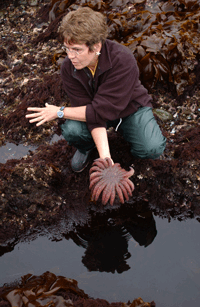
Jane Lubchenco is administrator of NOAA (Photo: Courtesy of the University of Oregon)
[THEME]
YOUNG: From the Jennifer and Ted Stanley Studios in Somerville, Massachusetts - this is Living on Earth. I’m Jeff Young. About five years ago, we got a wake up call with two reports describing oceans in crisis: plummeting fish populations; coastal habitat lost to sprawl; dead zones due to nutrient runoff. It was a pretty gloomy picture.
Well, now the federal government’s following recommendations from those reports with what could be a sea change for ocean management. The Obama administration has proposed a comprehensive oceans policy—one that pulls together plans for fishing, offshore energy, coastal protection and shipping—jobs that are now scattered across some 20 government agencies.
[HUBBUB; VOICES MURMURING IN BUSY ROOM]
YOUNG: A task force of top marine and environmental officials is getting feedback on the plan during a listening tour along the country’s coastline.
[TAPPING ON MICROPHONE]
SUTLEY: Hello, if you can all find a seat we’re about to started as soon as we…
YOUNG: Hundreds gathered for an afternoon hearing in Providence, Rhode Island—folks in the ocean state had a lot to say about oceans management. Greg Garrett was concerned about whales.
GARRETT: We now let our military with reckless abandon kill marine mammals. And, if your national policy doesn’t actually stop that then you haven’t done anybody any good.
YOUNG: Fishing communities advocate Angela Sanfilippo said trying to work with the government often leads to frustration.
SANFILIPPO: We know that if we don’t have a healthy ocean there’s no fish. We worked through these years with a lot of government agencies but it’s very difficult-- the army corps of engineers, the department of navy, the coast guard. It’s impossible to protect the ocean when you have to deal with so many people.
YOUNG: Fisherman Brian Loftis worried the plan could force guys like him off the water.
LOFTIS: There’s enough for everyone if they’d manage it properly, but that’s not what they’re trying to do. They’re trying to shrink everyone down, get rid of half the boats, and then the other ones will be owned by big corporations. The small independent guy is gonna go the way of the farmer, bye bye.

(Courtesy of Deepwater Wind)
YOUNG: The hearing went on into the night. Scientists asked for ecosystem-based management; energy developers urged more offshore wind power; ship captains argued against putting windmills in their way. What emerged here in nation’s smallest state was a microcosm of the issues and challenges for all of the country’s coasts.
[WAVES CRASHING; WIND BLOWING ON BEACH]
YOUNG: The next day I tagged along as task force members hit the beach with locals who explained what lessons little Rhode Island might hold. Grover Fugate directs the state’s Coastal Resource Management Council. He says the feds could learn from the planning that kept these dunes and salt ponds healthy even amid dense population.
FUGATE: They’re trying to understand what’s called marine spatial planning, which is essentially looking at the uses that are in the waterside and how they interact and how they can be planned rationally. And that’s what we’ve been doing in Rhode Island for 26 years. And we now have this ocean planning initiative that’s reaching much further out than any program has done before with an eye to where we can put renewable energy in these waters.
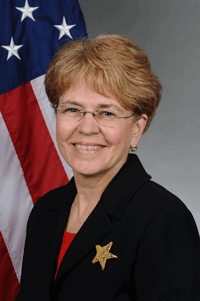
Jane Lubchenco
YOUNG: Like a lot of east coast states, Rhode Island is looking to its windy coast for energy. But some offshore wind projects are mired in controversy and delay. Deepwater Wind managing director Jim Lanard hopes his company can avoid that.
LANARD: Marine spatial planning, ocean zoning, is very important as we put industrial uses out into the oceans we have industrial fishing uses and now we’re going to have wind energy out there, as well. There needs to be coordination and collaboration.
YOUNG: So, from where we’re standing, where out there do you think your project might happen?
LANARD: The utility-scale project will be a little bit to our left, about 12 to 15 miles off the coast. There will be about 100 turbines out there, spread about a half mile apart. The utility-scale wind park will power 125 to 150,000 homes every year.
YOUNG: By going farther from shore, Deepwater would make its turbines less visible to beach tourists. But that could put windmills in the waters that fishermen have relied on for centuries. Lobsterman Lanny Dellinger says fishermen are trying to accommodate others.
DELINGER: There’s no alternative. I mean, the Obama administration has made it quite clear we’re gonna have these alternative energy projects. Now it’s time to figure out how we can do both. I think it’s a matter of sizing the industry so that we can have a sustainable fishery and a sustainable industry to harvest those fish.
YOUNG: Sizing the industry, though, that means some people aren’t going to be fishing anymore?
DELINGER: Absolutely. There’s gonna be winners and losers in the process. The best thing we can do is be part of the process early on, get a seat at the table with developers and scientists and help them mitigate those impacts.
YOUNG: There’s a lot here for the federal Ocean policy task force members like Jane Lubchenco to think about.
LUBCHENCO: I think it’s fair to say that the ocean is becoming an increasingly a crowded place. We are see increasing uses and also increasing conflicts.

Jane Lubchenco is administrator of NOAA (Photo: Courtesy of the University of Oregon)
YOUNG: Lubchenco is a highly respected marine ecologist and, since March, she’s been administrator of NOAA, the National Oceanic and Atmospheric Administration. I spoke with her about what she wants this new ocean policy to achieve.
LUBCHENCO: It’s pretty clear that it’s high time we take a more thoughtful look at what combination of activities can coexist in the ocean. If we want to have vibrant coastal communities and coastal economies, if we want the range of activities that people tell us they want from oceans, we really need to have healthy, resilient ocean and coastal ecosystems.
YOUNG: The state of the oceans sounds so dire. And, I understand you’re doing good things here, but they sound very bureaucratic - a reorganizing the flow chart sort of changes. Is that kind of change really going to do what we need given how seriously bad things are with our oceans?
LUBCHENCO: Both of the oceans commissions recognized that there are many problems that exist in oceans and they are only escalating with climate change; it’s sort of an overlay along with ocean acidification on top of a lot of the other ocean challenges. Both of them though pointed to one of the underlying drivers of change is that there is no integration, there’s no coordination. There is no mechanism for considering the health of the system as policies are being made.
So part of the challenge is to take a step back and say how can we be smarter about using oceans without using them up? And that’s very different from sort of the piece meal, sector by sector, one crisis management at a time that we have been doing over the last, I guess, pretty much forever.
YOUNG: Is there time to bring some of these fisheries that are plummeting back, is there time to stop what’s happening to our coral reefs, our coastlines?
LUBCHENCO: I take hope from the knowledge from my personal experience about the resiliency that does exist in many ocean ecosystems when they are allowed to recover they actually can. And so I think there’s actually a dual message here: one of urgency but, there is also great hope. So we believe that it is time to move ahead very aggressively in doing more recovery, but focusing not just on individual stocks of fish but on the health of the system. Because that, in fact, is what in the end will be important to people. Healthy oceans matter.
YOUNG: You can hear a longer interview with NOAA administrator Jane Lubchenko, and read a draft of the new ocean policy at our website, LOE dot ORG. The ocean’s task force has two more public hearings this month in New Orleans and Cleveland. The final plan goes to the President in December.
Related links:
- Click here to see multi-use planning maps
- Click here to hear our full interview with Jane Lubchenco
- Read the draft report from the Obama administration’s interagency oceans task force
- The Pew Ocean Commission report described oceans in crisis
[MUSIC: Fared Haque “The Chant” from ‘Flat Planet’ (Oel - 2009)]
Acid in the Arctic
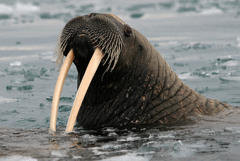
Walrus at Kvitoya in the Svalbard archipelago (Photo: Richard Mcmanus http://www.flickr.com/photos/22918294@N04/2725875168/in/set-72157622499318628/.)
YOUNG: As we heard, ocean acidification is one of the looming threats marine scientists are racing to better understand. As seawater absorbs carbon dioxide, it changes the pH. And recent research indicates this acidification could come fastest in the Arctic Ocean. Oceanographer James Orr is with LSCE, the Lab for Sciences of Climate and the Environment in Paris. Dr. Orr, what’s happening in the arctic waters?
ORR: The Arctic is a special case because basically, it’s cold, and, therefore, naturally more prone to acidification. So, CO2 is a gas, and like all gases, it’s more soluble in cold water. It’s not just the temperature. What sets off the Arctic from other areas is fresh water input due to river runoff, and the sea ice melting also has an impact, and actually aggravates the situation and makes it worse still.
YOUNG: So, you’ve done some work looking at what might happen in the pretty near future to the Arctic. What have you learned?
ORR: Within ten years, it’s expected that maybe ten percent of the Arctic Ocean could become corrosive to shells and mussels and clams. You hardly even need a model, you can just look at basic fundamental chemistry and the waters actually will dissolve aragonite, which an important form of shell material. That’s ten percent within ten years, and, as time goes on, as CO2 continues to increase, then it gets worse. At the end of the century, virtually all of the Arctic Ocean, as well as much of the southern ocean around Antarctica has become corrosive to this aragonite material.
YOUNG: Again, that’s the material that the animals depend on to build shells.
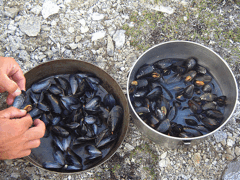
Arctic Mussels (Photo: http://www.flickr.com/photos/14636217@N00/243384793/)
ORR: Exactly, it’s a shell-forming material.
YOUNG: How does that compare to earlier projections on the rate of ocean acidification?
ORR: Well, the thing is not many people have looked at the Arctic. And also, you have to say that ocean acidification as a research area is really just in its infancy. It’s only about five years ago that many scientists started looking at this in earnest.
YOUNG: And what are the implications if within ten years we have some portion of the Arctic Ocean so acidic that it’s actually corrosive to marine organisms that form shells?
ORR: Well, that’s a really good question. We don’t know exactly what will happen to marine organisms. Just as a purely chemical, chemist’s viewpoint, we could say that the material will dissolve. But some of these organisms, such as the mollusks, the bivalves that are living on the bottom of the Arctic ocean are a very important food source for some mammals like walruses – they can eat 100 pounds of clams in a day, no problem.

Walrus at Kvitoya in the Svalbard archipelago (Photo: Richard Mcmanus http://www.flickr.com/photos/22918294@N04/2725875168/in/set-72157622499318628/.)
So, if that food source were to go away, we could expect that the walrus would have a more difficult time, given other threats at the same time, the retreat of the sea ice. It’s just an added pressure on the Arctic system and on those organisms, even marine mammals.
YOUNG: How important is the Arctic as a fishery, when you think of us in that food chain?
ORR: Well, that depends a bit on how you define the Arctic. The Bering Sea is the richest fishery within the US. So, it’s quite important.
YOUNG: What can we do about ocean acidification? Once an ocean becomes acidic, is there any way to fix it, to go back?
ORR: No, there’s no quick fix, unfortunately, the only solution is prevention. There are a lot of things we can do to emit less CO2 and to try, maybe, not to emit it directly to the atmosphere, maybe to store it in geological reservoirs. But, ultimately, we really have to try to limit the amount of CO2 in the atmosphere. The CO2 goes up, you can’t help but have the acidity of the ocean going up along with it, in lock step.
YOUNG: Oceanographer Dr. James Orr talking to us about his work on the Arctic Ocean. Thanks for your time.
ORR: Thanks, it was a pleasure.
Related links:
- Links: Dr. James Orr profile
- LOE 2007 story on Acid
[MUSIC: Dirt Dozen Brass Band “Flying High (In The Friendly Sky) from ‘What’s Going On’ (Shout Factory - 2006)]
YOUNG: Just ahead, a clean sweep of chemical regulations. Keep listening to Living on Earth!
Chemical Reform
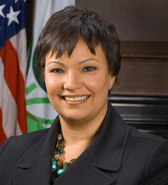
Lisa Jackson is administrator of the Environmental Protection Agency. (Courtesy of EPA)
YOUNG: It’s Living on Earth, I’m Jeff Young. We’ve reported a lot lately on BPA in plastics, the weed killer Atrazine, and the rocket fuel ingredient perchlorate – chemicals raising health concerns and building up in our environment despite a law intended to prevent that. Now, the Environmental Protection Agency’s administrator Lisa Jackson says the 30-year old law governing toxic chemicals is inadequate to protect the public.
She wants Congress to reform TOSCA – the Toxic Substances Control Act – to give her agency authority to move more quickly when scientists find health risks. Dr. Megan Schwarzman studies environmental health at the University of California, Berkeley. She coauthored a paper this summer titled “Toward a New U.S. Chemicals Policy”. Dr. Schwarzman, is that where we’re headed here, toward a new policy?
SCHWARZMAN: I really think it is. This is the first time in a generation that we’re really seeing this as an actual probability, in fact, a certainty, and there are several things that have led us in that direction, but this announcement by administrator Jackson indicating the administration’s will and goals for chemicals management for the country is truly significant.
YOUNG: Give us a sense of what EPA has been able to do under TOSCA, the existing law – what kind of progress have they made toward really regulating chemicals?
SCHWARZMAN: Well, it’s been over 30 years since TOSCA was passed, and in that time EPA has issued formal rules to restrict the use of only five chemicals, so that in itself when you’re comparing five to the universe of approximately 80,000 chemicals that are understood to be in use in the US, that’s a tremendously small number of substances that EPA has been able to act on and it makes you wonder whether they really have the tools they need to do their job.
YOUNG: Why is it that the current system does not allow EPA to make those priorities about what is or isn’t of chief concern?
SCHWARZMAN: To make priorities you have to have information, so to decide that one hazard is worse that another, to decide that benzene is worse than formaldehyde or is worse than asbestos, you need to know information about what exactly those hazards are. And basically, EPA has been denied that information. Without that information, they can’t set priorities and can’t determine what first needs to be acted on. The second thing that they lack is tools. So, they lack the information and they also lack the authority to require more information or to take action. They’re required to meet a burden of proof that is so high that they virtually can’t meet it.
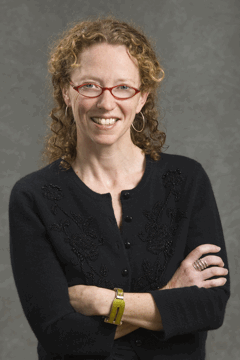
Megan Schwarzman
YOUNG: You know, another complaint that we’ve heard a lot of on this program from scientists who are looking into health concerns of different toxics chemicals is that everything is kind of done assuming a standard human, but there’s a little attention paid to people who might be more sensitive to the given health risks. Is that something that the EPA would take into account with these changes being proposed here?
SCHWARZMAN: These proposed changes do make a very significant statement that the first ever about the obligation to assess risks to sensitive sub-populations. And what we generally understand those to be are children, workers who tend to be exposed to higher amounts of chemicals than the average person, to communities who are disproportionately affected, those who live near toxic waste sites or what we call “fence line” communities, also extending it to women of child-bearing age, that’s a very sensitive population in terms of what the implications are of chemical exposures.
YOUNG: Now, in 2006, the European Union changed the way it does chemical regulation to something called REACH. How’s that affected what might happen here in the US?
SCHWARZMAN: It’s affected it tremendously. One thing that it does is make change here almost inevitable because one this that REACH does is it applies equally to European and foreign producers of chemicals. If you want to sell your product in Europe, you have to meet these requirements, and these requirements mean that you have to provide information about that chemical to the European chemicals agency that based on the volume of the chemical that you import or produce you have to provide increasing amounts of data. So, in fact, US companies who are not subject to those kind of requirements in the US are having to come into compliance with them to continue access to the world’s largest market, which is Europe.
YOUNG: I know a lot of people in the industry are moving toward, or are at least interested in moving toward, what’s called green chemistry, where they design products, you end up with a less toxic product or less pollution in the process. Does the current regulatory system encourage that, would these proposed changes encourage more of that?

Lisa Jackson is administrator of the Environmental Protection Agency. (Courtesy of EPA)
SCHWARZMAN: Currently, in the US, though we don’t have a lot of data requirements for introducing new chemicals, there are more data requirements for introducing a new chemical than for an old chemical, and that produces this sort of perverse incentive, it’s backwards – so that to do something innovative and to bring a new product to market, you actually have to provide information, than just using the same old product, and that really stifles innovation. I think these proposed changes are exactly what we need to encourage the innovation towards safer substances. That is green chemistry is this process of designing out the hazard of chemicals from the beginning.
We’ve clearly failed at mopping up the mess we make. The resources are overwhelmed, and these hazards have proved uncontainable, and so moving back upstream and sort of creating things that are sort of benign by design, as they say, seems really the only sustainable solution. So, the proposals for what new chemicals management should look like that came out of the EPA will go a long way, if they’re implemented, toward advancing that.
YOUNG: Dr. Megan Schwarzman is research scientist in Environmental Health Sciences at the University of California’s School of Public Health. Thanks for your time.
SCHWARZMAN: Thanks so much.
YOUNG: Now getting the chemicals law updated depends on Congress – we’ll keep you posted on that. For some of our reports on the chemicals of concern – go to our website, LOE dot ORG.
Related links:
- Click here for Dr. Schwarzman’s paper, “Toward a New U.S. Chemicals Policy”
- Click Here for LOE “Story BPA Update”
- LOE Story “Low Dose Makes the Poison”
- LOE Story “War of the Sciences”
- LOE Story “EPA’s Chemical Delay”
- LOE Story “Pesticides and Birth Defects”
- LOE Story “The Problem with Perchlorate”
[MUSIC: Marco Benevento “Golden” from ‘Me Not Me’ (Royal Potato Family - 2009)]
YOUNG: Coming up, saving water in the semiconductor business. But first, this note on emerging science from Annie Glausser.
Emerging Science Note/ Placenta Power
[SCIENCE NOTE THEME]
GLAUSSER: It’s the only organ to develop in adulthood. It’s the only organ to have a definite end point. And it could be the ticket to an abundant, cheap supply of stem cells. It is the placenta – a little known organ with big potential.
Normally, the placenta is discarded after it’s completed its task of nurturing a baby. But new science questions this knee-jerk disposal. Scientists at Children’s Hospital and Research Center Oakland say the placenta is an excellent source of blood stem cells that could provide every baby with a lifelong cell supply.
Blood stem cells are used to treat many blood disorders, such as leukemia and sickle cell disease. After birth, a placenta can be infused with cryopreservatives, frozen and stored. If stem cells are needed, the organ can be thawed and the cells extracted. The idea of harvesting blood stem cells after birth is not new. Umbilical cord blood has been collected since the 90s.
While people pay around $1000 up front for private cord blood banking – as well as about $100 a year for storage – there’s also a free public program. The public program gives cord blood to those in need, now, rather than saving it for a specific individual. Stem cells from the placenta are potentially even more useful than cord blood simply because there are more of them – three to five times more in fact. Placenta stem cells could help treat the nearly 16,000 people with serious blood-related disorders who are currently unable to find a matching donor. So, while the focus is on mother and baby during labor, it may be wise to think twice before tossing the afterbirth tissue, after birth. That’s this week’s note on emerging science. I’m Annie Glausser.
[THEME]
Related links:
- Children's Hospital and Research Center Oakland
- For more information on preserving blood stem cells from afterbirth tissues
Benign Design for the Environment
Photo courtesy of National Science Foundation.
YOUNG: Semiconductors are the building blocks of modern electronics – making our products smarter. But the way semiconductors are made isn’t always so smart when it comes to water. A single manufacturing plant can use as much water as a small city. One place in Arizona is working to turn those water guzzlers into sippers. It’s the Engineering Research Center for Environmentally Benign Semiconductor Manufacturing. Yeah, it’s a long name. But as Laurie Howell reports for the IEEE Spectrum Magazine and the National Science Foundation's "The Global Water Challenge" series, the engineers and students there also have a long list of water saving ideas.
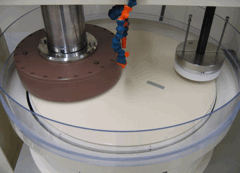
Polisher (Photo courtesy of National Science Foundation).
[SOUND OF POLISHER]
HOWELL: This mini-computer chip manufacturing plant is a test facility. Located in a warehouse on the University of Arizona campus, it’s where engineers recreate the industry’s water problems so they can fix them.
SUN: So, here is a typical 200-millimeter polisher – looks like – at the bottom is the rotating pad…
HOWELL: Chemical Engineer Ting Sun gives me a tour of the polishing room, lined with various sizes of flat, round silicon wafers.
SUN: And when we’re ready, we’re gonna bring the head down and the wafer will touch the pad. All of them are rotating, so they’re gonna do the polish work.
HOWELL: Polishers spin the silicon wafers against a pad and a chemical mix known as slurry, polishing each layer of circuitry and then rinsing it with ultra pure water. Sun has focused her research on engineering better pads.

Chemical engineer Ting Sun. (Photo courtesy of National Science Foundation.)
TING SUN: By doing that, we can use less chemicals, so we dump less chemical into the environment, so that helps a lot, and also by using less of chemical, we also use less water to rinse it.
HOWELL: Sun is schooled in a practice called “design for the environment,” a strategy that guides the center’s operations. Farhang Shadman directs the engineering research center.
SHADMAN: “Design for environment” basically means that those who are in charge of developing new processes will have the environmental, not only environmental thinking but also the tools and techniques of environmental assessment in their way of doing research.
HOWELL: The center’s full name is SRC/Sematech Engineering Research Center for Environmentally Benign Semiconductor Manufacturing. Under Shadman’s leadership, it’s grown to include nine US universities, since its 1996 launch.
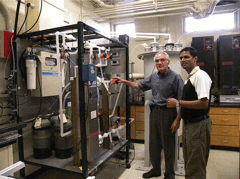
/Farhang Shadman (left) and doctoral student Kedar Dhane. (Courtesy of National Science Foundation.)
SHADMAN: Probably the legacy of the center is showing and proving, by many, many examples, that environmental approach to technology not only makes sense, not only it reduces cost, it may be the only way that future manufacturing is done.
HOWELL: Computer chip makers watch this center closely for new technologies, and it’s easy to understand why. Many semiconductor manufacturing plants are located in the water strapped cities of the Southwest.
SHADMAN: One manufacturing plant uses anywhere between two to four million gallons of very, very pure water, we call it ultra-pure water, per day, and that, on the average, is roughly equivalent to the water usage of a city of maybe 40 or 50,000 people.
Semiconductor (Courtesy of National Science Foundation)
HOWELL: Shadman guides me past a room with engineers dressed head to toe in what they call “cleanroom suits,” which protect the research from outside impurities. Just like surgery, semiconductor manufacturing requires a sterile environment.
SHADMAN: OK, what you see here is what we call a pilot plant, a water pilot plant, and it is very unique because it essentially resembles the water purification plants of semiconductor manufacturing except that everything is in smaller scale and everything is research development oriented so we can change things, things that you can not do in the real manufacturing.
HOWELL: So, what we’re looking at right here are different stations where the water goes through purification process, water softeners, carbon filters. And that’s because the water that’s needed in the semiconducting industry needs to be so pure, purer than any water, anywhere.

Water Purifier (Courtesy of National Science Foundation.)
SHADMAN: Yes, because the wafer that is being cleaned is already very clean. You’re trying to remove very, very small traces of impurity. So, if water has any contaminants in it, it will be harmful. Very interesting point is about bacteria. We cannot tolerate any bacteria – live or dead – it doesn’t matter, because of the fact that the bacteria typically have some of the trace elements in them like phosphorus, like carbon. These traces of these compounds would change the electrical properties of the silicon wafer.
HOWELL: And that could lead to defective computer chips and, ultimately, product recalls. So, chemical engineer Jun Yan has been developing a new water sensor that immediately detects when a silicon wafer is clean, so rinsing can stop, saving millions of gallons of water a day.
YAN: Environmental concern, environmental issue and how mankind, the civilization can survive depend on what can we do and how can we approach it, so I think it’s very exciting, you know, it’s very important, meaningful work.
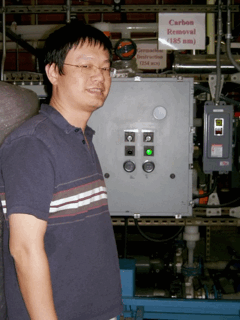
Chemical engineer Jun Yan. (Photo courtesy of National Science Foundation.)
HOWELL: The water sensor developed by Yan and his colleagues is already on the market and was named 2009 product of the year by SEMI, a global association for microelectronics and other industries. Again, Farhang Shadman.
SHADMAN: We want to make sure that manufacturing, particularly high technology manufacturing, is maintained and retained, kept in the United States, and if you do not solve some of these environmental issues and some of these resource issues, we stand the risk of losing that manufacturing to other areas.
HOWELL: The Center has now spun off five start-up companies. And, its environmental technologies are being applied outside semiconductor manufacturing and electronics, including the medical and pharmaceutical industries. For Living on Earth, I'm Laurie Howell in Tucson, Arizona.
YOUNG: Laurie Howell reported this story for the Global Water Challenge, a co-production of IEEE Spectrum magazine and the Directorate of Engineering for the National Science Foundation.
Related links:
- SRC/Sematech Engineering Research Center for Environmentally Benign Semiconductor Manufacturing.
- For a slide show on semi-conductors and more information on IEEE Spectrum’ and NSF’s Global Water Challenge series, click here:
[MUSIC: Erik Truffaz “Sweet Mercy” from ‘The Mask’ (Kameleon Music - 2000)]
Birds of Prey
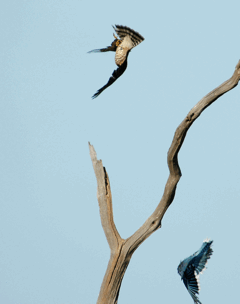
(Photo © Salt Marsh Diary)
YOUNG: No animal is more serious than a hawk on the hunt. But sometimes, as writer Mark Seth Lender observes, birds of prey become birds that play - whether they want to, or not.
LENDER: The Birds of Prey have begun their passage. Bottled up by bad weather they wait, and then upon the freshened air, a hurricane of hawks roars through. Goshawk and Broadwing, Rough-leg and Redtail, all are here. So are the falcons, Merlin with that Prussian dueling scar across his eye and thousand-yard stare. Kestrel, hovering above the marshland all bright feathers, formidable beyond her size.

(Photo © Salt Marsh Diary)
A Peregrine cutting across the shallowing sun, almost transparent in the penetrating light of late afternoon. While all the small that walk, that fly, that crawl, that climb quake with dread. Predators prey, prey flees. This morning we had a Sharp-shin. He too must feed and the songbirds fear this little hawk with reason. He may not succeed every time but he tries, sitting in plain sight on a naked branch while everyone hides. Except the Jays.
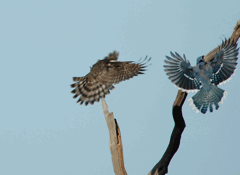
(Photo © Salt Marsh Diary)
One by one by one, Bluejays alight on the fork of the very same tree. A lethal error in judgment seems to lead them close, closer. Too close. Blasting from his perch the Sharpy strikes, the spurs of his talons scalpel-sharp, his feet spread like fangs. Twisting, he turns and dives head first, half upside down, dogging the nearest Jay, a tail feather’s width behind. The Bluejay, screaming blood and murder, escapes - just barely – and comes right back for more. And more.

(Photo © Salt Marsh Diary)
Each time that blinding terror, each time the narrow escape, each Jay taking his turn as if they want to be eaten. Suicide, by hawk! And then I understood: The Bluejays are playing a game. When we ride the Cyclone careening toward the bottom at an angle sure to jump those roller-coasting tracks - We scream! We love it. We ride that ride again. This is how the Bluejays play it. The hawk does not but then, not his turf, not his rules. One guess who tired first? Prey plays. Predators gnash their teeth. Smart money’s on the Game.
YOUNG: Mark Seth Lender writes the column, “Salt Marsh Diary.” To see photographs and find out more, go to our website LOE dot ORG.
Related link:
Salt Marsh Diary
[MUSIC: Various Artists “Shine On You Crazy Diamond” from ‘The Piano Tribute To Pink Floyd’ (Vitamin Records - 2005)]
YOUNG: Coming up, one man’s trash becomes another man’s windmill. Keep listening to Living on Earth!
ANNOUNCER: Support for the environmental health desk at Living On Earth comes from the Cedar Tree Foundation. Support also comes from the Richard and Rhoda Goldman fund for coverage of population and the environment. And from Gilman Ordway for coverage of conservation and environmental change. This is Living On Earth on PRI, Public Radio International.
Listener Letters
YOUNG: It's Living on Earth, I'm Jeff Young.
[THEME]
YOUNG: Time to catch up on comments from you, our listeners.
[THEME]
YOUNG: Some of you had sharp words about our coverage of the resignation of the White House’s Green Jobs advisor, Van Jones. Among them was Kenneth from Dallas who listens to our podcast. He writes that he usually enjoys our show – but found that report partisan.
He writes, “Your one-sided portrayal of the Van Jones resignation bothered me. I do not think that he should be a part of our government and I am concerned about having un-vetted Czars in high positions.” And ecologist Paul Rogers of Utah State University, thought our report on Sudden Aspen Decline painted too sad a picture. He says though some older trees are dying, in most places, healthy young sprouts are replacing them – that’s contrary to what a forest service pathologist told us. Our interview with the renegade lunch lady, who serves up nutritious school meals, had many of you asking for seconds. Charlotte Muller hears us on WAMC out of Kingston NY.
MULLER: I am a student at the Culinary Institute of America who has decided that I want to make my mission in life to reconnect Americans with their food and a healthier way of looking at food. I would LOVE to be a cook who went into a school and got a farmer to give their food to a school and then helped the cooks in the school learn to prepare it. Sign. Me. Up!
YOUNG: And finally - a listener who says it’s time for some straight talk about that talking seal.
[HOOVER THE SEAL TALKING]
YOUNG: George Swallow heard our story about Hoover the seal on Maine’s Public Broadcasting Network. He liked it, but says we got a couple of things wrong. And he ought to know: Swallow was 17 when his father, also named George Swallow, brought the orphaned pup home.
SWALLOW: My uncle, he’s a lobsterman, lives down from us, oh, about half a mile down the road. He called my father and said that his dog had found a baby seal, and my father was somebody who always took care of stray animals and hurt birds like that. So, my uncle called him and they went down and they found a seal, it was tiny, about a foot long. They looked around, they found its mother had been shot, so my father brought the seal home and they put it in the bathtub. That’s the first time I saw it. I think I came back from school that day, and my mother says come and look at this! And there was a seal in the bathtub.
[YOUNG LAUGHS]
YOUNG: I’m guessing eventually he got too big for the tub, what then?
SWALLOW: Oh, yeah, we had a pond in the back yard, freshwater pond. And my father would take him down to that and he would go in, swim around, and come out. And we set up a little pup tent, so that he could get out of the sun or stay in there at night and he did that.
YOUNG: A pup tent, how appropriate for a seal pup.
SWALLOW: Yea. [Laughs] And Odin College had a marine biology department and they got a marine biologist to come take a look at the seal, and he said he was okay in the pond, and he just need probably some vitamin supplements and some salt tablets, that they gave my father.
YOUNG: Now, Hoover’s famous for being the talking seal. Did Hoover talk to you, did you hear Hoover talking back then?
SWALLOW: No, I never heard Hoover talk back then. My father thought he heard the seal sort of say something that almost sounded like speech, but he didn’t really tell anybody because he thought they’d think he was a little nutty.
[YOUNG LAUGHS]
SWALLOW: And the vocalization didn’t start for a few years after he was at the aquarium, but as soon as we heard it, we knew where he got it from because he was saying things in my father’s accent, exact same thing my father repeated over and over. Like “Hello there,” and “Come over here,” “Get out of there” and “Hey, hey, stupid!” He’d always talk to the seal, constantly, but he never said the seal talked back. Not, until later.
YOUNG: Did he sort of just become like a pet? Sort of like a dog with flippers, or what?
SWALLOW: Yeah, actually it was quite a bit like having a pet dog. Actually, it’s one of the stories my father would talk about because the seal would ride in his jeep. I think he had a jeep then, it might have been a scout, but anyway one of these jeepy vehicles. And the seal would sit in the passenger seat, and one day he was up in the local town up here, Brunswick, and he stopped at a stoplight, some kids on s street corner looked at the jeep, and one of them goes, “Look! Look! That dog has got no ears!”
YOUNG: [Laughs] Now, your dad tried to return Hoover to the wild before Hoover ended up at the aquarium, right? How did that go?
SWALLOW: Well, he was getting fairly big, oh, a couple feet long at this point, and my father took him down in a skiff and put him in the water. He swam around, he liked that great, and my father started to come back in with the skiff, and thinking maybe he would just go and find some other seals, but he came swimming over and just flipped right into the boat. One of the people my father worked for got a hold of the aquarium, and they agreed to take the seal.
YOUNG: Now, your father’s not with us anymore, correct?
SWALLOW: No, he passed away in ’97.
YOUNG: And, apparently your family decided to memorialize Hoover along with your Dad’s memorial, correct?
SWALLOW: Yep, on his headstone there’s an engraving from a photograph…it was in the Boston Globe when they took Hoover down to the aquarium. My father’s holding Hoover, and Hoover’s kissing him, giving him a little nudge in the cheek.
YOUNG: Sweet. George Swallow, thank you very much for helping us get the story of Hoover the seal straight. I want to say now this story has the official seal of approval, doesn’t it?
SWALLOW: Okay, I guess it does! [Laughs]
[HOOVER TALKING]
Related link:
Hoover the Talking Seal Memorial
YOUNG: Alright, well, thanks to everyone for being in touch – we’re always glad to hear from you. You can reach us at comments at LOE dot ORG. Once again, comments at LOE dot ORG. Our postal address is 20 Holland Street, Somerville, Massachusetts, 02144. Or you can call our listener line at 800-218-9988. That's 800-218-99-88.
[MUSIC: The Meters “Loving You Is On My Mind” from ‘Rejuvenation’ (Atlantic Records - 2004)]
Turbine Trash
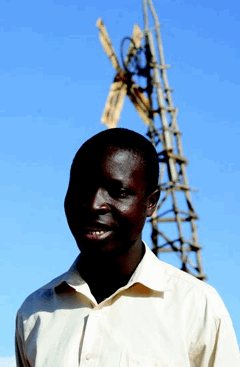
William Kamkwamba in front of his windmill.
YOUNG: In 2001, famine ravaged the sub-Saharan country of Malawi. William Kamkwamba and his family survived. But the suffering left him determined to find a way to protect them from drought and hunger. William was just 14. He had to drop out of school because his family couldn’t afford the fees. So William hit the books on his own, to learn how to build a windmill using whatever he could find. Now William and journalist Bryan Mealer have written a book, The Boy Who Harnessed the Wind. William, Bryan, welcome to the program.
KAMKWAMBA: Thank you.
MEALER: Thanks for having us.
YOUNG: William, why did you decide a windmill would keep your family from facing another famine?
KAMKWAMBA: So, what needed to be done to harvest enough food, we need to start doing irrigation, but the only way to start irrigation is to have a certain type of machine that can be pumping water to irrigate our crops, so it’s when I decided that if I was gonna build one of this machine, I’m gonna be able to do that.
YOUNG: So, tell me about actually making this, where did you get the parts, I imagine in rural Malawi you can’t just go to the hardware store and say, hey I need the parts for a windmill. Where did things come from?
KAMKWAMBA: So, at the time when I was making my windmill I didn’t even have money, but I got news to go to the hardware and buy materials, but my materials I found them at a junkyard. Every time I go to the junkyard to look for my materials, I didn’t have any specific material to look for, but I was just picking up any piece of metal, thinking that maybe I’ll use it and then when I was doing that lots of people are laughing at me, thinking that I am going crazy because they say that it is not normal for a normal person to go into a junkyard collecting all the garbages and then telling people that I’m trying to do the windmill.
YOUNG: And, Bryan?
MEALER: Yea, I was just gonna give a little bit of background, and brag about him a little bit. You know, when he was going to the library and reading these books, and the first one was this British physics book called “Explaining Physics,” William didn’t really know how to read English that well, but it had these really beautiful illustrations and diagrams, and he was able to basically take these diagrams and where it said like ‘figure ten,’ he would look into the text and he would learn the English words and basically was able to teach himself basic physics.

William Kamkwamba in front of his windmill.
And he was really interested in bicycle dynamos, and how they worked because people used dynamos to power their head lamps on their bicycles, so he would always go around, he would ask, “How does this work, why is this producing light?” But, nobody knew so he realized that you could actually take the wires out of the lamp, itself, and they produce kind of a shock, and he would kind of shock himself while he was spinning it.
And he was able to figure out that you can ram these wires into the AC plug of a radio, and he saw this other book with the windmills on the cover that said windmills produce electricity through spinning motion. He kind of put those two things together – the dynamo with the spinning motion of the generator inside, and the turbine is the generator, and that’s what brought it all together.
YOUNG: Ah ha. So, you’re picking through this stuff from the junkyard, everybody thinks you’re basically crazy, you can’t go to school, and yet, you’re finding stuff that starts to sort of kind of look like it could be a windmill.
KAMKWAMBA: Yeah, when I was going through the junkyard, I was just wandering around in tall grasses looking for any kind of piece, putting them together. Once, I was picking up pieces of metals, examining it before I take it home, thinking about how I’m going to use this type of piece here.
YOUNG: What did you use for the blades? What were the rotors, the blades?
KAMKWAMBA: For the blades, I used PVC pipes, which I’m melting over the fire and then I stretched them. For the shaft of the windmill, I used this shock absorber to make the shaft I’m using. And old bicycle frame for the frame of the windmill.
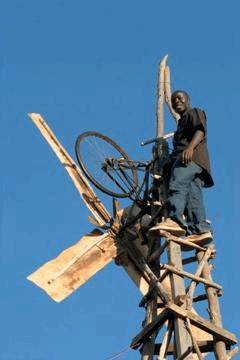
William Kamkwamba standing on his homemade windmill.
YOUNG: And reading this is just amazing, you didn’t even have a drill! So, to make the holes, you had to what? You were heating up a nail a poking it through the plastic, is that right?
KAMKWAMBA: Yeah, for the drill I was using the nail, I was hitting the nail. When the nail gets hot now, I would be driving hot nail into a PVC pipe. It was slow process because by the time I’m picking it up to the place I want to drill the nail has cooled, so I had to run back and forth.
YOUNG: So, melted pieces of PVC pipe for the blades, tractor fan from a tractor engine for the hub, hooked up to an old shock absorber for the crankshaft. Then, what? Then you need something that’s actually going to make the juice, make the electricity. Where did that come from?
KAMKWAMBA: After I found all these things, I needed one piece, which I couldn’t find at the junkyard. That piece was a bicycle dynamo, which was too expensive. Luckily enough, my friend Gibbat bought it for me, so when he brought that dynamo, I was able to generate electricity when I hook the top to the windmill.
YOUNG: And then, came the moment of truth. Where you put this on top of a tower, which you also made, tell me about that. Tell me about the time when you first got this thing spinning.
KAMKWAMBA: Yeah, um, when the blades were spinning and they are generating electricity the light bulb came on from the windmill and the people are starting clapping hands and there was a crowd of people watching there. There was kids, and then the kids are pushing each other to, for a better look. For me it was like wow. This is the time now. I was very happy, because I have been working on the project for quite a long time and I was like proving to people that what I’ve been working on, it wasn’t craziness, but it was something useful for which can be generating electricity. For me, it was one of the exciting moment of my life.
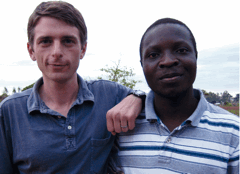
William Kamkwamba and Bryan Mealer.
YOUNG: So, while you were rummaging through the junkyard people though you were crazy, but once you had a light and a radio and things like this in your house, what did people in the village of Wimbe begin to think of you then?
KAMKWAMBA: After I did all this, people started coming to charge their mobile phones. There was also another time when we experienced the drought in 2005 and what was happening is that people started pointing to my windmill, saying that this is the witch tower that is chasing away the rain, it’s not science.
YOUNG: Wait a minute; people were blaming your windmill for the fact that there was no rain?
KAMKWAMBA: Yeah, because they are seeing that the wind was starting blowing. When the wind is blowing, it was blowing the clouds and my windmill was spinning so fast. That’s why people say that, no, it’s this machine that is something magic – it’s witch tower that is blowing away the rain clouds.
YOUNG: Hmm. Bryan, you’ve covered Africa a lot as a journalist. Give us some sense of the kind of mindset that is at work there when people saw a windmill and thought it was chasing away the clouds and causing a drought.
MEALER: The way he was explaining it to me in Malawi is there are too many problems for God and man alone, so there exists this third invisible world of magic that can kind of, that helps them along. And so William, when he starts collecting his garbage, and not only do people say he’s crazy or he’s smoking marijuana or whatever, you know he’s talking insane – he’s saying I’m gonna create electricity from wind. And they said only a witch can do that, you know, good luck.
YOUNG: You know, William, it occurs to me you brought a light, a physically light into your house, but it seems you me you brought a different kind of light to your village – the light of using science.
KAMKWAMBA: I’ve just noticed that nowadays the mindset of people have really changed. Where before they are thinking that they are not to do anything in terms of science, it’s only people from the West for European people who can be doing something for the science. So, that type of mindset for lots of people has really changed.
YOUNG: Bryan, do you recall when you first heard or learned about what it was William was doing?
MEALER: Yeah, clearly. Prior to meeting William, I’d been a reporter in Africa for about five years, most of that time was spent covering the war in the Democratic Republic of Congo, and the whole time I was working in Congo, Africans themselves always ask us, “Why do you guys only cover our bad news? Why don’t you cover our good news?” I see this Wall Street Journal article about a guy in Malawi who builds windmills out of garbage, and I said, man, this is that story! This is the story I’ve been looking to tell. And to me, this is the way you save Africa. You don’t throw money at it, you don’t throw food aid at it, you go and find these guys. And we need to comb that continent and find guys like this, and not give them money, but give them little slivers of opportunity and lift them up.
YOUNG: William, do I understand correctly that in your native language, there’s no word for windmill. Is that right?
KAMKWAMBA: Yeah, that’s right. I used the word ‘magetsi a mphepo,’ so it just means electric wind.
YOUNG: Electric wind? That’s got a nice ring to it. Yeah, so that’s how you describe it to people when they ask, what is that? You said, electric wind. Bryan Mealer and William Kamkwamba co-authored “The Boy Who Harnessed The Wind.” Thank you both very much for your time.
KAMKWAMBA/MEALER: Thanks for having us.
YOUNG: William Kamkwamba’s going back to school at a South African academy for future African leaders. He’s already started a club there for fellow inventors; he calls it the Doers Club. Can’t wait to see what he does next.
Related links:
- Bryan Mealer’s website
- William Kamkwamba’s blog and website
[MUSIC: Fernando Perez “African Dance, Malawi Africa” from ‘Music Of The World In The Guitar Of Fernando Perez’ (Fernando Perez - 2005)]
YOUNG: On the next Living on Earth, tiny architects teach us new ways to ventilate buildings.
TURNER: The really interesting trick termites have done is they’ve learned a way to exploit turbulent wind energy that for a long time wind engineers have kind of looked down upon.
YOUNG: Green design inspired by termites. Next time, on Living on Earth.
[MUSIC]
YOUNG: Living on Earth is produced by the World Media Foundation. Our crew includes Bobby Bascomb, Eileen Bolinsky, Bruce Gellerman, Annie Glausser, Ingrid Lobet, Helen Palmer, Jessica Ilyse Smith, Ike Sriskandarajah, and Mitra Taj, with help from Sarah Calkins, Marilyn Govoni, and Sammy Souza.
YOUNG: Our interns are Quincy Campbell and Nirja Parekh. Jeff Turton is our technical director. Alison Lirish Dean composed our themes. You can find us anytime at LOE dot ORG. Steve Curwood is our executive producer. I'm Jeff Young. Thanks for listening.
ANNOUNCER: Funding for Living On Earth comes from the National Science Foundation supporting coverage of emerging science. And Stonyfield farm, organic yogurt and smoothies. Stonyfield pays its farmers not to use artificial growth hormones on their cows. Details at Stonyfield dot com. Support also comes from you, our listeners. The Ford Foundation, The Town Creek Foundation, and The Oak Foundation supporting coverage of climate change and marine issues. The Rockefeller Foundation and its campaign for American workers. More at rockfound dot org. And Pax World Mutual Funds, socially and environmentally sustainable investing. Pax world for tomorrow. On the web at pax world dot com.
ANNOUNCER 2: PRI – Public Radio International.
Living on Earth wants to hear from you!
Living on Earth
62 Calef Highway, Suite 212
Lee, NH 03861
Telephone: 617-287-4121
E-mail: comments@loe.org
Newsletter [Click here]
Donate to Living on Earth!
Living on Earth is an independent media program and relies entirely on contributions from listeners and institutions supporting public service. Please donate now to preserve an independent environmental voice.
NewsletterLiving on Earth offers a weekly delivery of the show's rundown to your mailbox. Sign up for our newsletter today!
 Sailors For The Sea: Be the change you want to sea.
Sailors For The Sea: Be the change you want to sea.
 The Grantham Foundation for the Protection of the Environment: Committed to protecting and improving the health of the global environment.
The Grantham Foundation for the Protection of the Environment: Committed to protecting and improving the health of the global environment.
 Contribute to Living on Earth and receive, as our gift to you, an archival print of one of Mark Seth Lender's extraordinary wildlife photographs. Follow the link to see Mark's current collection of photographs.
Contribute to Living on Earth and receive, as our gift to you, an archival print of one of Mark Seth Lender's extraordinary wildlife photographs. Follow the link to see Mark's current collection of photographs.
 Buy a signed copy of Mark Seth Lender's book Smeagull the Seagull & support Living on Earth
Buy a signed copy of Mark Seth Lender's book Smeagull the Seagull & support Living on Earth

